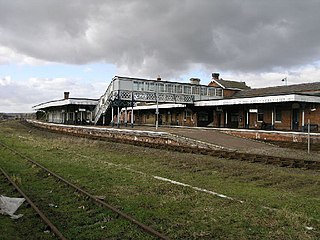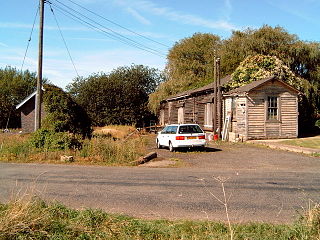
Bourne is a market town and civil parish in the South Kesteven district of Lincolnshire, England. It lies on the eastern slopes of the limestone Kesteven Uplands and the western edge of the Fens, 11 miles north-east of Stamford, 12 miles west of Spalding and 17 miles north of Peterborough. The population at the 2011 census was 14,456. A 2019 estimate put it at 16,780.

The A15 is a major road in England. It runs north from Peterborough via Market Deeping, Bourne, Sleaford and Lincoln along a variety of ancient, Roman, and Turnpike alignments before it is interrupted at its junction with the M180 near Scawby. The road restarts 10 miles (16 km) east, and then continues north past Barton-upon-Humber, crossing the Humber on the Humber Bridge before terminating at Hessle near Kingston upon Hull.

Aslackby and Laughton is a civil parish in the South Kesteven district of Lincolnshire, England. According to the 2001 census the parish had a population of 243, in 102 households. increasing slightly to 251 in 118 households at the 2011 census. It consists of the village of Aslackby, the hamlet of Laughton, and scattered farms, and part of the hamlet of Graby.

Aunsby and Dembleby is a civil parish in the North Kesteven district of Lincolnshire, England. According to the 2001 Census it had a population of 125. The parish includes Aunsby and Dembleby, which were separate parishes until 1931, and the hamlet of Scott Willoughby.

Billingborough is a village and civil parish in the South Kesteven district of Lincolnshire, England. It is situated approximately 10 miles (16 km) north of Bourne and 10 miles south of Sleaford, and on the B1177 between Horbling and Pointon just south of the A52.

Sleaford railway station serves the town of Sleaford in Lincolnshire, England. It lies on the Peterborough–Lincoln line. The station is 21.25 miles (34 km) south of Lincoln Central.

Spalding railway station serves the town of Spalding, Lincolnshire, England. It lies on the Peterborough–Lincoln line.

Kirkby la Thorpe is a village and civil parish in North Kesteven district of Lincolnshire, England.The population at the 2011 census was 1,120. It lies 1.5 miles (2.4 km) east from Sleaford. The village is near the start of the A17 Sleaford bypass.

Horbling is a village and civil parish in the South Kesteven district of Lincolnshire, England. It lies on the B1177, 7 miles (11 km) south-east of Sleaford, 14.5 miles (23 km) north-east of Grantham and 0.5 miles (0.8 km) north of Billingborough.

Rippingale is a village and civil parish in the South Kesteven district of Lincolnshire, England. The population of the civil parish was 929 at the 2011 census. The village is situated on the A15 road, about 5 miles (8 km) north from Bourne.

North Drove railway station was a station serving Pode Hole in Lincolnshire, England. It was on the route of the Spalding and Bourne Railway, later part of the Midland and Great Northern Joint Railway.

Twenty railway station served the village of Twenty, Lincolnshire. It was on the route of the Spalding and Bourne Railway, later part of the Midland and Eastern Railway and then part of the Midland and Great Northern Joint Railway main line between the Midlands and the Norfolk Coast.

Bourne was a railway station serving the town of Bourne in Lincolnshire which opened in 1860 and closed to passengers in 1959.
Thurlby railway station was a station in Thurlby by Bourne, Lincolnshire on the Bourn and Essendine Railway between Essendine and Bourne. It was closed in 1951.

Rippingale railway station was a station serving the villages of Rippingale, Dowsby and Dunsby, Lincolnshire on the Great Northern Railway Bourne and Sleaford railway. It opened in 1872 and closed to passengers in 1930. The section from Bourne through Rippingale to Billingborough remained open for goods until 1964.

Billingborough and Horbling railway station was a station serving the villages of Billingborough, Horbling and Threekingham, Lincolnshire on the Great Northern Railway Bourne and Sleaford railway. It opened in 1872 and closed to passengers in 1930. The section from Bourne to Billingborough remained open for goods until 1964.

Wilsthorpe is a village in the district of South Kesteven in the county of Lincolnshire, England. It is situated approximately 6 miles (10 km) north-east from Stamford and approximately 4 miles (6 km) south from Bourne. The population is included in the civil parish of Braceborough and Wilsthorpe.

Aswarby and Scredington railway station was a station close to Scredington, Lincolnshire on the Great Northern Railway Bourne and Sleaford railway. It opened in 1872 and closed in 1930. It was originally shown on maps as Aswarby Station, but by 1905 it was shown as Aswarby and Scredington Station.
Mareham Lane is an unclassified road between Graby and Sleaford in Lincolnshire, England. It is approximately 10.6 miles (17.1 km) long.

The Bourne and Sleaford Railway was promoted as a branch of the Great Northern Railway to fend off an expected incursion by the rival Great Eastern Railway. It was authorised by Parliament in 1865, but not opened until 1871 and 1872. Although agricultural traffic provided healthy business, the rural character of the line never produced much passenger trade, and it was closed to passengers in 1930. The line was severed and ceased to be a through line in 1956 and closed completely in 1965.

















